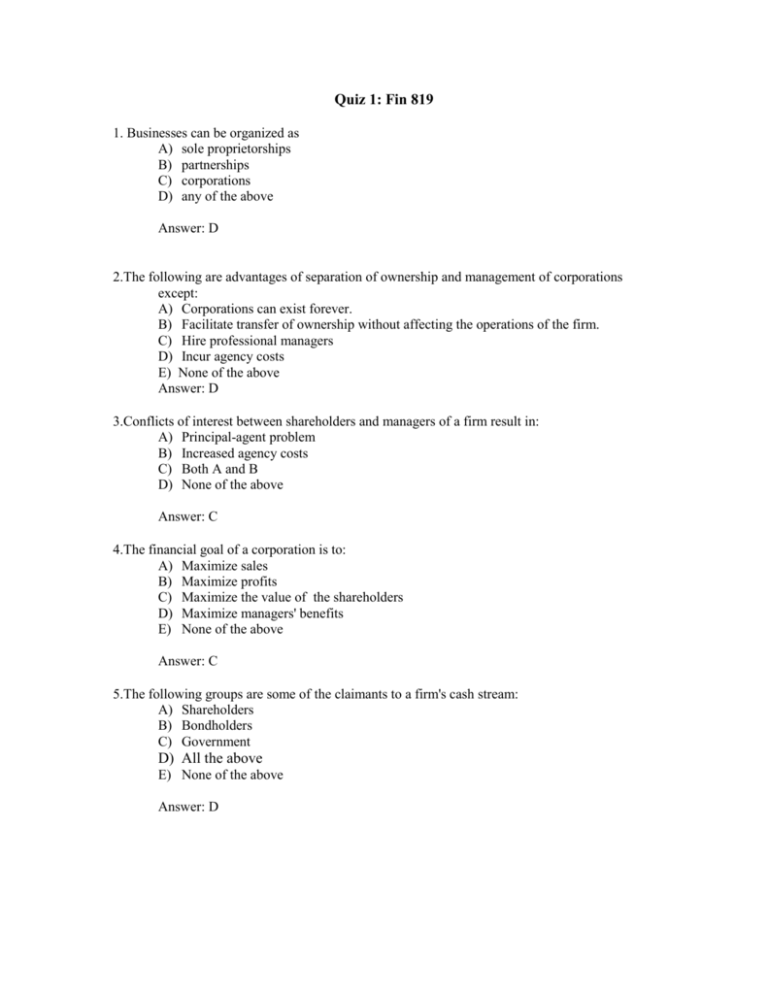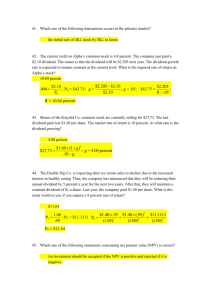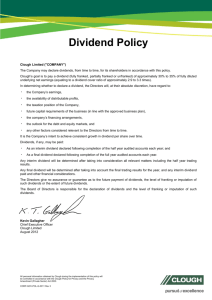Quiz 1: Fin 819-02
advertisement

Quiz 1: Fin 819 1. Businesses can be organized as A) sole proprietorships B) partnerships C) corporations D) any of the above Answer: D 2.The following are advantages of separation of ownership and management of corporations except: A) Corporations can exist forever. B) Facilitate transfer of ownership without affecting the operations of the firm. C) Hire professional managers D) Incur agency costs E) None of the above Answer: D 3.Conflicts of interest between shareholders and managers of a firm result in: A) Principal-agent problem B) Increased agency costs C) Both A and B D) None of the above Answer: C 4.The financial goal of a corporation is to: A) Maximize sales B) Maximize profits C) Maximize the value of the shareholders D) Maximize managers' benefits E) None of the above Answer: C 5.The following groups are some of the claimants to a firm's cash stream: A) Shareholders B) Bondholders C) Government D) All the above E) None of the above Answer: D 6.A firm's investment decision is also called the: A) Financing decision B) Capital budgeting decision C) Liquidity decision D) None of the above Answer: B 7. Two year discount factor at a discount rate of 10% per year is: A) 1.1 B) 1.0 C) 0.909 D) 0.826 E) None of the above Answer: D Response: Discount Factor = 1/1.12 = 0.826 8. The following statements regarding the NPV rule and the rate of return rule are true except: A) Reject a project if its rate of return > opportunity cost of capital B) Reject a project if its NPV < 0 C) Reject a project if its rate of return < opportunity cost of capital D) Accept a project if its rate of return > opportunity cost of capital E) None of the above Answer: A 9. The opportunity cost of capital for a risky project is A) The expected rate of return on a government security having the same maturity as the project B) The expected rate of return on a well diversified portfolio of common stocks C) The expected rate of return on the market portfolio of all the assets D) None of the above Answer: D 10. Mr. Dell has $120 income this year and zero income next year. The market interest rate is 10% per year. Mr. Dell also has another investment opportunity in which he can invest $50 this year and receive $70 next year. Suppose Mr. Dell consumes $50 this year and invests the remaining in the project and the market. What is the maximum amount of money Mr. Dell has next year ? A) $90 B) $95 C) $100 D) $120 E) None of the above. Answer: E Response: =70+20*1.1=$92 11.Which of the following statements regarding the net present value rule and the rate of return rule is true? A) Accept a project if the rate of return is larger than the cost of the capital B) Accept a project if the rate of return on a risky project exceeds the risk-free rate C) Accept a project if the net present value is larger than the rate of return D) None of the above statements are true Answer: A 12. There are two reasons for discounting future cash flow. They are: A) A dollar today is worth more than a dollar tomorrow (for positive interest rates) B) The value of a dollar is decreasing over time C) A risky dollar is worth less than a safe one D) A and C above E) A and B above Answer: D 13. The managers of a firm can maximize stockholder wealth by: A) Taking all projects with positive NPVs B) Taking all projects with NPVs greater than the cost of investment C) Taking all projects with NPVs greater than present value of cash flow D) All of the above Answer: A 14. What is the present value of the following cash flow at a 12% discount rate? Year 0 Year 2 Year 3 100,000 150,000 200,000 A) B) C) D) E) $351,221 $450,000 $493,440 $673,200 None of the above Answer: E Response: PV = 100,000 + (150,000/(1.12^2)) + 200,000/(1.12^3) = $361,935.1 15. What is the net present value of the following cash flows at a discount rate on 10%? t=0 -250,000 A) B) C) D) E) t=1 100,000 t=2 150,000 t=3 200,000 $101,221 $200,000 $142,208 $115,139 none of the above Answer: D Response: NPV = -250,000 + (100,000/1.1) + (150,000/(1.1^2)) + 200,000/(1.1^3) = 115,139 16. You would like to have enough money saved to receive a growing annuity of 40 years, growing at a rate of 4% per year, the first payment being $60,000, after retirement so that you can lead a good life. How much would you need to save in your retirement fund to achieve this goal (assume that the growing annuity payments start one year from the date of your retirement. The interest rate is 8%)? A) $7,500,002 B) $1,500,005 C) $1,600,003 D) $1,168,507 E) None of the above Answer: D Response: PV = (60,000/(0.08-0.04))*(1-1.0440/1.0840) = $1,168,507 17. After retirement, you expect to live for 30 years. You would like to have $80,000 income each year. How much should you have saved in the retirement to receive this income, if the interest is 10% per year (assume that the payments start one year after the retirement)? A) $681,085 B) $1,600,300 C) $538,200 D) None of the above Answer: D Response: PV = [(1/0.10)- (1/((0.10)(1.10^30)))]*80,000 = $754,153 18. If the present value of $1.00 received n years from today at an interest rate of r is 0.621, then what is the future value of $1.00 invested today at an interest rate of r for 2n years? A) $2.59 B) $1.61 C) $2.70 D) Not enough information to solve the problem Answer: A Response: FV = 1/(0.621*0.621) = 2.59 19. Which of the following statements is true? A) Present value of an annuity due is always less than the present value of an equivalent annuity for a given interest rate ( an annuity due means immediate cash flows now) B) The present value of an annuity approaches the present value of a perpetuity as n goes to infinity for a given interest rate C) Both A and B are true D) Both A and B are false Answer: B 20. Which of the following statements regarding simple interest and compound interest are true? A) Problems in finance generally use the simple interest concept B) Problems in finance generally use the compound interest concept C) It does not really matter whether you use simple interest or compound interest for solving problems in finance D) None of the above Answer: B 21. If we use the payback period rule with a required payback period of 4 years to examine the projects being taken by many small firms, which of the following may be the reason for us to reject these projects? (assume that all the projects require initial investments) A) B) C) D) E) The cash flow at year 1 is larger than the initial investment cost The sum of the cash flows in the first three years is less than the initial cost These projects don’t produce any positive cash flows in the first five years A and B None of the above Answer: C 22. Given the following cash flows for project A: C0 = -2000, C1 = +500 , C2 = +1400 and C3 = -5000, C4=$200,000, which of the following is true for the payback period? A) The payback period is one year B) The payback period is 2 years C) The payback period is 3 years D) The payback period is larger than 3 years E) none of the above Answer: D 23. The IRR is defined as: A) The discount rate that makes the NPV greater than zero B) The difference between the cost of capital and the present value of the cash flows C) The discount rate that makes the sum of all the cash flows zero. D) The discount rate used in the discounted payback period method E) None of the above Answer: E 24. Given the following cash flows for Project M: C0 = -1,000, C1 = +500, C2 = +1,500, C3 = +5,555, calculate the IRR for the project. A) 10% B) 18% C) 28% D) None of the above E) Any of the above Answer: D 25. Project A has the following cash flows: C0 = -100, C1 = 120. The IRR of the project is 20% and if the cost of capital is 15%, you would: A) Accept the project B) Reject the project C) There is no enough information D) None of the above Answer: A Response: This is a project with NPV >0 26.Company Imagine has a cost of capital at 12% and $10 million to take some projects from the following available projects (units in million US dollars) to maximize the profits: Project C0 A B C D -7 -8 -2 -2.5 NPV at 12% 14 18 6 5 Which set of projects should company Imagine take? A) B) C) D) E) A B B and C A and D none of the above Answer: C 27.Net Working Capital (simply referred to as working capital) is the: A) Difference between short-term assets and short term liabilities B) Difference between long-term assets and long term liabilities C) Difference between long-term assets and short term liabilities D) None of the above Answer: A 28 .Capital equipment costing $200,000 today has 50,000 salvage value at the end of year 5. In addition, working capital of $10,000 is built up today. If the straight line depreciation method is used, what is the book value of the equipment at the end of year two? A) $200,000 B) $170,000 C) $140,000 D) $50,000 Answer: C Response: Annual depreciation = (200,000 -50,000)/5 = 30,000 Book value at the end of two years = 200,000 -60,000 = 140,000 29.For project X, year 5 inventories decrease by $5,000, accounts receivables increase by $3,000 and accounts payables decrease by $2,000. Calculate the increase or decrease in working capital for year 5. A) Increases by $6,000 B) Decreases by $6,000 C) Increases by $8,000 D) there is no change E) None of the above Answer: D Response: Working capital: -5000 + 3000 +2000 = 0 30.You have been asked to evaluate a project with infinite life. Sales and costs are projected to be $600 and $100 respectively next year. There is no depreciation and the tax rate is 30%. The real required rate of return is 10%. The inflation rate is 4% and is expected to be 4% forever. Sales and costs will increase at the rate of inflation. If the project costs $2000, what is the NPV? A) $365.38 B) $1629.62 C) $500.00 D) $1,365.38 E) None of the above Answer: D Response: [((600/1.04)-(100/1.04))*(0.7)] / 0.1 - 2000 = $1,365.38 31.Super Computer Company's stock is selling for $100 per share today. It is expected that this stock will pay a dividend of 5 dollars per share, and then be sold for $120 per share at the end of one year. Calculate the expected rate of return for Super Computer Company ‘s stock. A) 20% B) 25% C) 10% D) 15% E) None of the above Answer: B Response: r = (120+5-100)/100 = 25% 32. PC Company stockholders expect to receive a year-end dividend of $10 per share and then be sold for $122 dollars per share. If the required rate of return for the stock is 20%, what is the current value of the stock? A) $100 B) $122 C) $132 D) $110 E) None of the above Answer: D Response: P = (122+10)/1.2 = 110 33. The constant dividend growth formula P0 = D1/(r-g) assumes: A) The dividends are growing at a constant rate g forever. B) r > g C) g is never negative. D) Both A and B E) None of the above Answer: D 34. Casino Co. is expected to pay a dividend of $6 per share at the end of year one and these dividends are expected to grow at a constant rate of 8% per year forever. If the required rate of return on the stock is 20%, what is the current value of the stock today? A) $30 B) $50 C) $100 D) $54 E) None of the above Answer: B Response: P = (6/(0.2-0.08) = 50 35.WorldTour Co. has just now paid a dividend of $6 per share (Do), the dividends are expected to grow at a constant rate of 5% per year forever. If the required rate of return on the stock is 15%, what is the current value on stock (after paying the dividend)? A) $63 B) $56 C) $40 D) $48 E) None of the above Answer: A Response: P = (6*1.05)/(0.15 0.05) = 63 36. The required rate of return or the market capitalization rate is estimated as follows: A) Dividend yield + expected rate of growth in dividends B) Dividend yield - expected rate of growth in dividends C) Dividend yield / expected rate of growth in dividends D) (Dividend yield) * (expected rate of growth in dividends) E) None of the above Answer: A 37. Mcom Co. is expected to pay a dividend of $4 per share at the end of year one and the dividends are expected to grow at a constant rate of 4% forever. If the current price of the stock is $25 per share, calculate the required rate of return or the market capitalization rate for the stock. A) 4% B) 16% C) 20% D) None of the above. E) None of the above Answer: C Response: r = (4/25) + 0.04 = 20% 38. Dividend growth rate for a stable firm can be estimated as: A) Plow back ratio * the return on equity (ROE) B) Plow back ratio / the return on equity (ROE) C) Plow back ratio +the return on equity (ROE) D) Plow back ratio - the return on equity (ROE) E) None of the above Answer: A 39. MJ Co. pays out 60% of its earnings as dividends. Its return on equity is 20%. What is the dividend growth rate for the firm? A) 3% B) 5% C) 8% D) 12% E) None of the above Answer: C Response: g = (1 - 0.6)*20 = 8% 40. Michigan Motor Company is currently paying a dividend of $1.50 per year. The dividends are expected to grow at a rate of 20% for the next three years and then a constant rate of 6 % thereafter. What is the expected dividend per share in year 5? A) $2.59 B) $2.00 C) $2.91 D) $1.50 E) None of the above Answer: C Response: D5 = (1.5) * (1.2^3) * (1.06^2) = 2.91 41.Y2K Technology Corporation has just paid a dividend of $0.40 per share. The dividends are expected to grow at 30% per year for the next two years and at 5% per year thereafter. If the required rate of return in the stock is 15% (APR), calculate the expected price of the stock next year (after the dividend payment). A) $1.420 B) $6.33 C) $5.63 D) Any of the above E) None of the above Answer: E Response: Po = [(0.4 * 1.3^2)/(1.15)] + [(0.4 * 1.3^2*1.05)/((1.15 * (0.15- 0.05))] = $6.76 42. Lake Co. has paid a dividend of $2 per share out of earnings of $4 per share. If the book value per share is $25, what is the expected growth rate in dividends (g)? A) 16% B) 12% C) 8% D) 4% E) None of the above Answer: C Response: g = (1 -0.5) (4/25) = 0.08 or 8% 43.Lake Co. has just paid a dividend $2 per share out of earnings of $4 per share. If the book value per share is $25 and is currently selling for $30 per share, calculate the required rate of return on the stock. A) 7.2% B) 15.2% C) 14.7% D) 16.6% E) None of the above Answer: B Response: g = (1- 0.5)(4/25) = 0.08 or 8%; [(2*1.08)/30] + 0.08 = 15.2 %. 44.The value of the stock: A) Increases as the dividend growth rate increases B) Increases as the required rate of return decreases C) Increases as the required rate of return increases D) Both A and B E) None of the above Answer: D 45. Woe Co. is expected to pay a dividend or $4.00 per share out of earnings of $7.50 per share. If the required rate of return on the stock is 15% and dividends are growing at a current rate of 10% per year, calculate the present value of the growth opportunity for the stock (PVGO). A) $80 B) $50 C) $30 D) $26 E) None of the above Answer: C Response: No growth value = 7.5/0.15 = 50; Po = 4/ (0.15-0.1) = 80; PVGO = 80-50 = 30 46.Current price of Company X's stock is $80. The table below gives the data on the nend of the year prices and probabilities dependent on the state of the economy. Calculate the expected return for the stock (no dividends). Economy Growth Recession A) B) C) D) 12.0% 15.0% 20.5% 17.5% Probability .5 .5 End of the year price $130 $ 90 E) None of the above Answer: E Response: Expected Price = 0.5*130 + 0.5*90 = 110; Expected return = (110 -80)/80 = 37.5%







